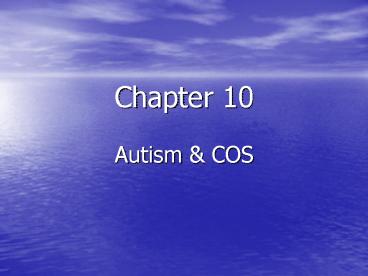Chapter 10 Autism - PowerPoint PPT Presentation
1 / 21
Title:
Chapter 10 Autism
Description:
Theory of Mind (ToM) ... Children with autism can have problems with their senses taking in information ... less severe social and language deficits ... – PowerPoint PPT presentation
Number of Views:59
Avg rating:3.0/5.0
Title: Chapter 10 Autism
1
Chapter 10Autism COS
2
Autistic Disorder
- Impairment in social interaction
- Nonverbal behavior
- Poor peer relationships
- Lack of spontaneous engagement
- Lack of reciprocity
- Impairments in communication
- Spoken language
- Conversation skills
- Odd language (Echolalia/Scripting)
- Imaginary play
- Restricted behaviors/interests
- Odd preoccupation or obsessions
- Abnormal rituals
- Repetitive movements
3
Other Developmental Disorders
- Childhood Disintegration Disorder
- Retts Disorder
- Pervasive Developmental disorder
4
Aspergers Disorder
- THE GOOD
- Normal language development
- No mental retardation
- THE BAD
- Poor nonverbal skills
- THE UGLY
- More psychiatric outcomes
5
Rule out
- Cultural issues
- Trauma
- Language Issues
- Anxiety
6
Assessment
- Childhood Autism Rating Scale
- Short rating scale
- Easily completed
- Based on observation
- Subjective
- Autism Diagnostic Inventory
- Structured interview
7
Etiology (What causes Autism?)
- Brain abnormalities
- Macrocephaly (Large head)
- Epilepsy
- Mirror Neurons
- Genetic abnormalities
- Fragile X syndrome
- Metabolic Disorders
8
Etiology (What causes Autism?)
- Environmental causes
- 1960s refrigerator moms
- Toxins (lead, mercury, etc.)
- Infections (rubella)
- Immunizations
- Allergies
9
Etiology (What causes Autism?)
- Polygenic (multiply caused)
Genes
Brain Development
Environment
Metabolism
10
Theory of Mind (ToM)
- We are all individuals with distinct thoughts,
emotions experiences, desires, and motivations - ToM argues that Autistic children do not
recognize the separation of self from others - ToM argues that children with autism are limited
in their ability and motivation to understand and
predict the behaviors of other
11
Sensory Dysfunction
Children with autism can have problems with their
senses taking in information (Hypersensitive) Too
much (Hyposensitive)
Too little
- Hypersensitive
- Withdrawal behavior
- Rocking/calming behaviors
- Distractibility
- Tantrums
- Repetitive tasks
- Hyposensitive
- Self-stimulatory behavior
- Self-injury
- Disruptive behaviors
- Unresponsive behavior
12
Cause Effect
- When I do _____________, then ______________
happens. - If I want _____________ to happen, then I need to
do ___________.
13
Treatment
- What are the goals?
- Skills (language and social)
- Behavior (appropriate)
- Motivation
14
Treatment (Skills)
- Discrete Trial Training
- present and rehearse short tasks for mastery
- Task Analysis
- Break down larger tasks into smaller parts for
mastery - Incidental Teaching
- Use natural situations to teach skills
15
Treatment (Skills Behavior)
- Dr. Ivar Lovaas- over 40 years of work and
research. - Applied Behavior Analysis (ABA)
- Choose target skills to increase
- Choose target behaviors to decrease
- Uses reinforcement and punishment
16
Treatment (Motivation, Skills, Behavior)
- Floortime
- Drs. Stanley Greenspan Serena Weider
- Targets motivation and allows the skills and
behaviors to follow
17
Floortime Goals
- Encouraging engagement
- Increasing two-way communication
- Encouraging expression of feelings
- Promoting logical thinking
18
Childhood Onset Schizophrenia (COS)
- Historically applied to children who today would
be diagnosed ASD - COS
- a later age of onset
- less intellectual impairment,
- less severe social and language deficits
- hallucinations and delusions, periods of
remission and relapse
19
DSM-IV Features of COS
- Hallucinations- often auditory
- Delusions
- Disorganized speech
- Disorganized or catatonic behavior
- Negative symptoms (e.g., flat affect, alogia,
avolition)
20
Causes of COS
- Current views emphasize a vulnerability-stress
model - Preliminary evidence suggest a strong genetic
contribution in COS, even more so than for adults - COS appears to be particularly associated with
family stress - Neurodevelopmental model does not explain this
well
21
Treatment of COS
- Chronic disorder with a poor long-term prognosis
- Pharmacological treatments often used
- Psychosocial treatments
- social skills training
- family intervention
- educational supports































